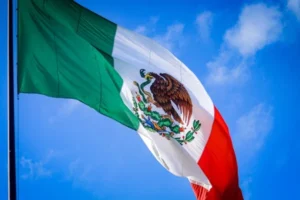Background: Chapultepec Forest.
The term Chapultepec is of Nahuatl origin which means “the hill of the chapulín” or “the hill of the grasshopper”. Vessels and pieces found in archaeological excavations date from a history of three thousand years and refer to its first settlers on the shores of Lake Texcoco. Forest of 700 hectares and lung of the city, was occupied by the Mexicas, chalcas and xochimilcas in different waves of migrations and expulsions.
It was considered a sacred site and area of vital importance for the water sources that allowed it to supply the recently founded City of Mexico, Tenochtitlán in 1325. After being annexed to the capital by royal mandate of the Viceroyalty, it became a recreation site of the viceroys where they made horseback rides and practiced the sport hunting of animals of the area such as rabbits and deer very English style.
Viceroy Bernardo de Gálvez began the construction of a building or rest palace on the heights of the hill, the Chapultepec Castle, to supplant another that was destroyed a year earlier by an explosion of gunpowder. The Chapultepec forest was used as a place of military training until its deforestation by American soldiers in the war against the United States.
From the last third of the S. XIX began its total recovery and transformation to become one of the most beautiful parks in the world of the last century with an artificial lagoon and hills of various sizes that give it landscape variety. It has fountains, beautifully ornamented places, a zoo, the Museum of Anthropology, Modern Art and Tamayo Contemporary Art.
History of Chapultepec Castle.
There are previous vestiges of Amerindian constructions of pools and baths of Montezuma, place of worship and housing complexes in the place. Later the Hermitage of San Miguel Arcángel was built and the first stage of the Castle as a resting palace by the Viceroy Bernardo de Gálvez between 1785 and 1787. By the years of the war of independence it was closed. It was in 1833 that it welcomed the military school into its bosom and by 1847 the battle of Chapultepec arose where the “hero children” of the school joined the resistance of the attack in the war against the United States.
Later it became the residence of the imperial couple Maximilian and Charlotte. Known as Miravalle Castle and neoclassical style, it is renovated for the new leaders with balconies, towers and gardens being baptized with its current name. With the departure of Maximilian from power in 1867 it closed its doors again and then opened as an Astronomical Observatory in 1878 working until 1883. At the end of the last third of the nineteenth century it was destined to be a presidential house. In February 1939 it was appointed by decree by President Lázaro Cárdenas, National Museum of History and formally inaugurated in September 1944.
The Castle is made up of more than 50 rooms. It consists of game room, reading room, dining room, tea room, bedrooms, smoking room, living room with cabinets for the toilet. The smoking lounge was banned for women. It was a male meeting place where liquor was drank and cigars were smoked. The tea room was used by Charlotte to officiate meetings while Maximilian was away. In Maximilian’s time a Boulevard was built attached to its entrance called El Paseo de la Reforma.
A walk through Mexican history.
If you want to know Mexican history from the dawn to the twentieth century, you must visit the National Museum of History. It is located inside the Chapultepec Castle and protects the largest historical heritage of Mexico, divided and sectored by areas.
The Chapultepec Castle and the National Museum of History have more than 40 exhibition rooms where the history of Mexico is summarized. It is divided into two exhibition areas: in the first area there are 12 rooms where you can take a walk through the national history from the Spanish conquest to 1910, the time of the Mexican Revolution. It is located in the wing where the Military College worked which are: room 1, “Two isolated continents”; room 2,3,4 and 5, “The Kingdom of New Spain”; room 6, “The War of Independence”; rooms 7 and 8, “The Young Nation”; room 9 and 10, “Towards the New Modernity”; Room 11 and 12, “Siglo XX”.
In the second area called the Alcazar with 12 rooms, there are the rooms, belongings and furniture of Emperor Maximilian and his wife Carlota, and General Porfirio Díaz and his wife Carmen Romero Rubio. This area is complemented by an exhibition space that commemorates the assault on Chapultepec Castle on September 13, 1847.
This area consists of the following: room 14, “Malachite Hall, the Pleasure of Beauty”; room 15, “Hall of Viceroys, The Instances of Power”; The Carriage Hall; The Introductory Room; the Reading Room; The games room; the Smoking Room; Hall of the Gobelins; the Tea Room; the Living Room; the Agreements Chamber; the Ambassadors’ Hall; the room of the Battle of Chapultepec; the Prelude to Agreements; the Ladder of the Lions; the Emplomados Gallery; The Office of the President. Special mention is the Alcázar Garden, an intimate space where greenery is integrated with architecture.
The National Museum houses collections, sculptures, paintings, works of art, antique coins, musical instruments, silver and porcelain belongings. The National Museum of History is of great national significance because its mission is the research, protection, preservation and dissemination of the country’s historical heritage.
Presidential Residence.
To continue with the tradition of being home to personalities of political power, first of all Viceroys in colonial times, the Chapultepec Castle also served as a residence for several presidents of Mexico. During the presidency of Manuel González it was decreed and transformed into an official hostel. Then it was occupied by Porfirio Díaz, who as a curious note introduced technological advances such as the incorporation of electric light and the first elevator of which it is still exhibited as historical heritage. He was followed by Francisco I. Madero, Venustiano Carranza, Álvaro Obregón, Plutarco Elías Calles, Emilio Portes Gil, Pascual Ortiz Rubio and finally Abelardo Rodríguez.
Artistic Collection
Mexico is home to an important artistic movement called Muralismo Mexicano and chapultepec Castle is the repository of a representation of artists who adorned its walls with their works of great social historical content. Among them we can name Jorge González Camarena and “Fusion of two cultures” in room 2; Juan O’Gorman and “Retablo de la Independencia” in room 6; José Clemente Orozco and “La Reforma y Caída del Imperio” in room 8; Juan O’Gorman and “El Feudalismo Porfirista” in Sala Madero; Juan O’Gorman and “Retablo de la Revolución” in Sala Madero; Jorge González Camarena and “La Constitución de 1917” in Sala de Videos Siglo XX; Gabriel Flores and “The North American Intervention” in the Dome of the main entrance; David Alfaro Siqueiros and “From Porfirismo to the Revolution” in Sala Siqueiros.
Currently the National Museum of History in the Castle of Chapultepec has under its care 65,000 pieces and objects of great historical and cultural value. It also has viceregal furniture, utensils, belongings, coins, costumes, sculptures in ivory, clay, silver that evoke the prolific past of these lands. In its facilities there are also cultural presentations, dances, concerts and theatrical works, being a cultural artistic icon of the city.
In the Castle there are some exhibitions, among them “Chimalli, Treasure of Moctezuma in Chapultepec”, “The Reform Freedom, Justice and Law. La Moneda del ejército Libertad del Sur en el centenario luctuoso de Emiliano Zapata”, “El cumpleaños de Carlota”, “Colección de Ramón Alcázar. From private enjoyment to public delight”, “Threads of History of the Clothing Collections of the National Museum of History”, “The Infinite North, Indigenous People in Movement”, “The Contrast Art in the Viceroyalties of Mexico and Peru”.
Anecdote and Curiosities
There were many curious facts and anecdotes starring in this majestic place. One of them was that the first Christmas tree exhibited in Mexico was placed in chapultepec Castle in 1864. This action was later emulated by Mexican high society.
In 1896 the cinema arrived in Mexico with the first screening in the Castle and whose audience was President Porfirio Díaz, relatives and members of the executive branch.
Benito Juárez upon assuming the presidency only stayed one day, July 14, 1867, as he moved to the National Palace.
In 1996 it became the location and film set for the film Romeo and Juliet starring Leonardo Di Caprio and also a scene from Raquel de Cantinflas’ Bolero.
Like any castle or old building can not miss the ghost story and appeared so it makes it very attractive. Employees report that it is haunted since on many occasions they have witnessed apparitions and the ghost of Carlota as if walking in search of Maximilian. Sounds of shackles, footsteps, chains and horses galloping in addition to Charlotte’s piano. From now on you can visit the facilities of the Chapultepec Castle and you will be guaranteed a walk full of history and majesty.










